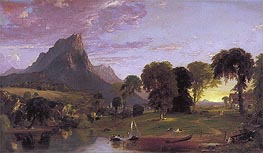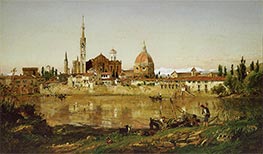
Jasper Francis Cropsey Painting Reproductions 1 of 1
1823-1900
American Hudson River School Painter
Jasper Francis Cropsey (February 18, 1823 - April 23, 1900) was an important American landscape artist of the Hudson River School.
Cropsey was born on his father Jasper Cropsey's farm in Rossville on Staten Island, New York, the oldest of eight children. As a young boy, Cropsey had recurring periods of poor health. While absent from school, Cropsey taught himself to draw. His early drawings included architectural sketches and landscapes drawn on notepads and in the margins of his schoolbooks.
Trained as an architect, he set up his own office in 1843. Cropsey studied watercolor and life drawing at the National Academy of Design and first exhibited at there in 1844. A year later he was elected an associate member and turned exclusively to landscape painting in the 1840s, shortly after he was featured in an exhibition entitled "Italian Compositions." Cropsey married Maria Cooley in May 1847, traveled in Europe from 1847-1849, was elected a full member of the Academy in 1851, and lived in England 1856-1863. During this time he specialized in autumnal landscape paintings of the northeastern United States, often idealized and with vivid colors. He cofounded the American Society of Painters in Water Colors in 1867.
Cropsey's interest in architecture continued throughout his life and was a strong influence in his painting, most evident in his precise arrangement and outline of forms. But Cropsey was best known for his lavish use of color and, as a first-generation member from the Hudson River School, painted autumn landscapes that startled viewers with their boldness and brilliance. As an artist, he believed landscapes were the highest art form and that nature was a direct manifestation of God. He also felt a patriotic affiliation with nature and saw his paintings as depicting the rugged and unspoiled qualities of America.
Jasper Cropsey died in anonymity but was rediscovered by galleries and collectors in the 1960s. Today, Cropsey's paintings are found in most major American museums, including the National Gallery of Art, the Metropolitan Museum of Art, the Los Angeles County Museum of Art, the Timken Museum of Art in San Diego, the Fine Arts Museums of San Francisco, the Denver Art Museum, and the Museum of Fine Arts, Boston. Works by Cropsey also hang in the White House.
Cropsey's home and studio, "Ever Rest", in Hastings-on-Hudson, New York as well as the largest permanent collection of Cropsey's work are open for tours by the Newington-Cropsey Foundation.
Cropsey and his wife Maria are buried in Sleepy Hollow Cemetery in Sleepy Hollow, New York.
Cropsey was born on his father Jasper Cropsey's farm in Rossville on Staten Island, New York, the oldest of eight children. As a young boy, Cropsey had recurring periods of poor health. While absent from school, Cropsey taught himself to draw. His early drawings included architectural sketches and landscapes drawn on notepads and in the margins of his schoolbooks.
Trained as an architect, he set up his own office in 1843. Cropsey studied watercolor and life drawing at the National Academy of Design and first exhibited at there in 1844. A year later he was elected an associate member and turned exclusively to landscape painting in the 1840s, shortly after he was featured in an exhibition entitled "Italian Compositions." Cropsey married Maria Cooley in May 1847, traveled in Europe from 1847-1849, was elected a full member of the Academy in 1851, and lived in England 1856-1863. During this time he specialized in autumnal landscape paintings of the northeastern United States, often idealized and with vivid colors. He cofounded the American Society of Painters in Water Colors in 1867.
Cropsey's interest in architecture continued throughout his life and was a strong influence in his painting, most evident in his precise arrangement and outline of forms. But Cropsey was best known for his lavish use of color and, as a first-generation member from the Hudson River School, painted autumn landscapes that startled viewers with their boldness and brilliance. As an artist, he believed landscapes were the highest art form and that nature was a direct manifestation of God. He also felt a patriotic affiliation with nature and saw his paintings as depicting the rugged and unspoiled qualities of America.
Jasper Cropsey died in anonymity but was rediscovered by galleries and collectors in the 1960s. Today, Cropsey's paintings are found in most major American museums, including the National Gallery of Art, the Metropolitan Museum of Art, the Los Angeles County Museum of Art, the Timken Museum of Art in San Diego, the Fine Arts Museums of San Francisco, the Denver Art Museum, and the Museum of Fine Arts, Boston. Works by Cropsey also hang in the White House.
Cropsey's home and studio, "Ever Rest", in Hastings-on-Hudson, New York as well as the largest permanent collection of Cropsey's work are open for tours by the Newington-Cropsey Foundation.
Cropsey and his wife Maria are buried in Sleepy Hollow Cemetery in Sleepy Hollow, New York.
3 Jasper Francis Cropsey Paintings

View near Sherburne, Chenango County, New York 1853
Oil Painting
$1074
$1074
Canvas Print
$54.62
$54.62
SKU: CJF-5714
Jasper Francis Cropsey
Original Size: 61.5 x 104.8 cm
Thyssen-Bornemisza Museum, Madrid, Spain
Jasper Francis Cropsey
Original Size: 61.5 x 104.8 cm
Thyssen-Bornemisza Museum, Madrid, Spain

Greenwood Lake 1870
Oil Painting
$1131
$1131
Canvas Print
$54.62
$54.62
SKU: CJF-17549
Jasper Francis Cropsey
Original Size: 97 x 174 cm
Thyssen-Bornemisza Museum, Madrid, Spain
Jasper Francis Cropsey
Original Size: 97 x 174 cm
Thyssen-Bornemisza Museum, Madrid, Spain

Florence 1875
Oil Painting
$871
$871
Canvas Print
$54.62
$54.62
SKU: CJF-18663
Jasper Francis Cropsey
Original Size: 30.5 x 50.8 cm
Carnegie Museum of Art, Pittsburgh, USA
Jasper Francis Cropsey
Original Size: 30.5 x 50.8 cm
Carnegie Museum of Art, Pittsburgh, USA